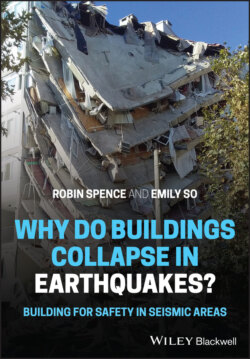Читать книгу Why do buildings collapse in earthquakes? Building for safety in seismic areas - Robin Spence - Страница 11
1.2 Earthquakes, Buildings, People
ОглавлениеOne of the reasons why earthquake risk does not get acted on is because it is not well understood by the public. Although the likely locations of large earthquakes are now known, the timescale of their recurrence is very long, and for most people at risk the last occurrence of ‘the big one’ for which they need to be prepared is many centuries ago, often before the present cities existed. People may be aware that they are living in an earthquake zone but fail to appreciate the possibility of events much larger than recent experience. In 2008, a modelling exercise, the California Shakeout, was done to support earthquake protection action for Southern California, which is threatened by a large earthquake on the San Andreas Fault (Jones and Benthian 2011). Lucy Jones, who led the modelling team speaks of the ‘normalisation bias, the human inability to see beyond ourselves, so that what we experience now or in our recent memory becomes our definition of what is possible’. Seismologists had identified much greater earthquakes in the past than those in recent memory, but the last great earthquake on that section of the San Andreas Fault was in 1688. The modelling exercise, based on a plausible, but by no means worst‐case scenario magnitude 7.8 earthquake on the southern section of the San Andreas Fault, showed that around 1500 buildings would collapse, and 300 000 would be severely damaged, causing around 1800 deaths and $213 billion losses. Fires would break out and could become uncontrollable. And the disruption caused to roads and pipelines would cause massive disruption to business, lasting for months. This modelling exercise led to a huge public awareness and preparation programme which has resulted in much reduced risks in California over the past decade.
But considerably more devastating consequences face many of the growing cities in other earthquake zones, particularly in Asia. The southern edge of the Eurasian Plate, stretching from the Mediterranean to China, and including Myanmar and Indonesia, is responsible for 85% of the world's historic earthquake deaths. And this is a region in which cities are today growing rapidly both in size and in number, fuelled by global population rise and urbanisation. Seismologist Roger Musson points to the risk in Tehran, today a city of 12 million people. The last major earthquake on the North Tehran Fault, passing close to the city centre, was in 1834 at a time when Tehran was a small town: an earthquake of M > 7 hitting Tehran today could cause as many as 1.4 million deaths. And seismologist Roger Bilham (2009) has estimated that a direct hit on a megacity (>10 million population) somewhere in the world once a century is now statistically probable, with a possible death toll exceeding one million, because of the combination of hazardous locations and structural vulnerability. The World Bank estimates that three billion people will live in substandard housing by 2030. By 2050, the UN projects that two‐thirds of the world's population, around 7 billion people, will live in urban areas.
Unfortunately, because the threat to each city is seen as remote, protection from earthquakes is given a lower priority than other issues. Few households prioritise spending on safety from future earthquakes above pressing immediate concerns, like providing extra space or better comfort, unless required to do so by regulation. And elected governments tend to look for expenditure programmes and new regulations which will give returns within their current tenure of office, despite evidence that money spent on disaster mitigation often avoids much greater losses over time. For this reason, general development expenditure is given priority over disaster risk mitigation. And even within that part of government budgets devoted to natural disasters, those from other natural hazards are often given priority. Windstorm and flood damage are more immediate risks, particularly as these are becoming worse as a result of climate change.
Optimistically and opportunistically, the climate change agenda has provided a global focus on resilience of communities to natural threats. It is recognised that especially in developing countries, cycles of disasters have depleted decades of progress made in development. The deaths and destruction from earthquakes are preventable. Whilst the hazard itself is natural, the disasters are largely man‐made, and completely preventable with proactive interventions.
